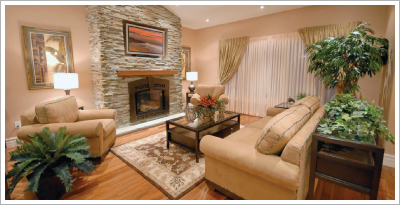It doesn’t take much to revitalize the energy of your home; just a little bit of inspiration and a touch of sensitivity. Through materials, texture and colours, we can change the energy of any space to one that exuberates vibrancy and inspiration.
Through sight and perception, we can rearrange spaces to suit our sense of taste and habits, yet at the same time create a living environment that exudes happiness and an expression of relief and satisfaction.
Here are 5 great tips to consider when revitalizing the energy of your home.
Tip 1 – Create The Bright Hall Within The Home
 The bright hall typifies the expanse of space at the front entrance of your home. By space I refer to that feeling of spatial freedom when you move from one room to another. To do so, you need to study the orientation and placement of your main door.
The bright hall typifies the expanse of space at the front entrance of your home. By space I refer to that feeling of spatial freedom when you move from one room to another. To do so, you need to study the orientation and placement of your main door.
Typical to most homes, the main entrance is segregated to its own space entity either in the form of an entry foyer or a portico-style design. But if you were to integrate the main entrance to the annex living areas, it helps to expand the front sector of the home whereby the immediate view on entry is the large expanse of the living room.
Avoid barriers in front of the door such as light partitions where you have to navigate around them to move to the next space. By ‘opening up’ the space, this technique immediately expands your front door sector many times over.
Other ideas may involve more construction work such as the use of a double height volume space. By creating a void between the ground and upper levels, it draws attention upwards, giving the sense of an explosion of space which evokes a sublime feeling of a spatial bright hall.
Tip 2 – Make Use Of What Is Existing
 Don’t change what is already there. Sometimes if you get too inventive, you may end up with a brand new set of problems that come with it. Take for example the location of the toilet. While these areas may constrict the size of casual spaces such as bedrooms and living areas, relocating a toilet may prove to be a strenuous task as it may involve piping and waterproofing issues.
Don’t change what is already there. Sometimes if you get too inventive, you may end up with a brand new set of problems that come with it. Take for example the location of the toilet. While these areas may constrict the size of casual spaces such as bedrooms and living areas, relocating a toilet may prove to be a strenuous task as it may involve piping and waterproofing issues.
So play with the space that you have. Any space can be transformed to look designed if you play with your palette of materials. Here are some fast tips for a toilet design.
- Select a dark coloured floor tile to give the space a strong foundation.
- Use light coloured wall tiles with accented patterns to lift the space.
- Introduce mirrors as a visual medium to double up the width of the space.
- Play with the type of lights. Spotlights help to highlight certain features yet maintain a subtle ambience. Wall lights help brighten up the room, so use this light technique for make-up areas only.
- Highlight the design properties of the sink. As this area is the most widely used part of the bathroom, a high-end finish draws attention to the classiness of the space.
Tip 3 – Use Colours to Create Different Moods
 In life we are attracted to two things – colour and light. The selection of colour can play a vital role in how we perceive or experience a space.
In life we are attracted to two things – colour and light. The selection of colour can play a vital role in how we perceive or experience a space.
For example, the colour red describes a colour of vibrancy, energy and heat. In feng shui terms, red is symbolic of the element of fire. Therefore, such colours should be avoided in areas where you don’t need energy such as bedrooms and bathrooms, and limited to areas like the dining and kitchen.
Blues remind us of the soothing experience by the sea or the colour of the sky; a colour that reflects peace and serenity and thus an ideal colour for the bedrooms. Greens describe the colour of nature, vegetation and tranquility. So for the bedrooms, you can stick to these two colour codes.
Living areas require a bit of life and light, so keep within the colour spectrum of yellow or beige tones. Yellows and light browns offer a sense of earth tones, which usually match most furniture styles.
Changing colours is an inexpensive technique to revitalize any space. Just the notion of a colour change immediately alters the overall expression, so when selecting what colour to use, remember to take note of how colours can affect our moods and its impact on the room design.
Tip 4 – Mix and Match Materials
 The use of materials can change the mood setting of the room depending on how you match your material palette together. Carpets offer a soft touch to the interiors but such materials can also absorb heat considerably, so unless you intend to air-condition such spaces, it may result in a claustrophobic feel. Otherwise, carpets offer a medium where you can easily change the colours and texture depending on how you want to decorate the space.
The use of materials can change the mood setting of the room depending on how you match your material palette together. Carpets offer a soft touch to the interiors but such materials can also absorb heat considerably, so unless you intend to air-condition such spaces, it may result in a claustrophobic feel. Otherwise, carpets offer a medium where you can easily change the colours and texture depending on how you want to decorate the space.
Deep colours give a calming feel as they absorb most of the ambient light in the room to create a relaxing environment for the user. Light coloured carpets on the other hand offer vibrancy and a refreshing outlook to the space.
When selecting the type of floor material, it is important to understand the differences in terms of space visualization. Marble or hard stone finishes give a room an upper edge of classiness, but if not treated with soft furnishings, can turn out to be too cold or yin. Wood gives a room a warm feel and should be complimented with light coloured furniture and occasional carpets to break up the monotony of the space. Other ways to soften the outlook of a space is to introduce curtains and soft furnishings, which not only affect the ambient colour but can also be used to decorate the wall surfaces to avoid unnecessary hardness.
Tip 5 – Make Full Use of Lights
 The final tip involves the use of lighting. Lights brings a vital source of energy and is the key element to setting the mood of any space. Depending on what you are trying to achieve, lights can help highlight or tone down certain areas of the room. Fluorescent lighting helps flood the room with an ambient feel.
The final tip involves the use of lighting. Lights brings a vital source of energy and is the key element to setting the mood of any space. Depending on what you are trying to achieve, lights can help highlight or tone down certain areas of the room. Fluorescent lighting helps flood the room with an ambient feel.
For living spaces, use warm white lighting to soften the overall mood. It achieves this by providing a yellowish hue to any room. For working conditions, use a harder light scheme such as natural daylight as it forces the user to perk up and is more conducive to productive work.
To highlight certain areas of the room, consider the use of low wattage halogen pelmets to create ‘light’ feature walls, which help add attention to certain areas you wish to emphasize.
Through the play of colours, lights and materials, you are able to transform any room in your home to suit your creativity and personal taste. The secret to achieving an interior design that you find appealing and gratifying is to maintain a balance in these 3 design ingredients so the immediate reaction to a space is one that is filled with satisfaction and solace.























